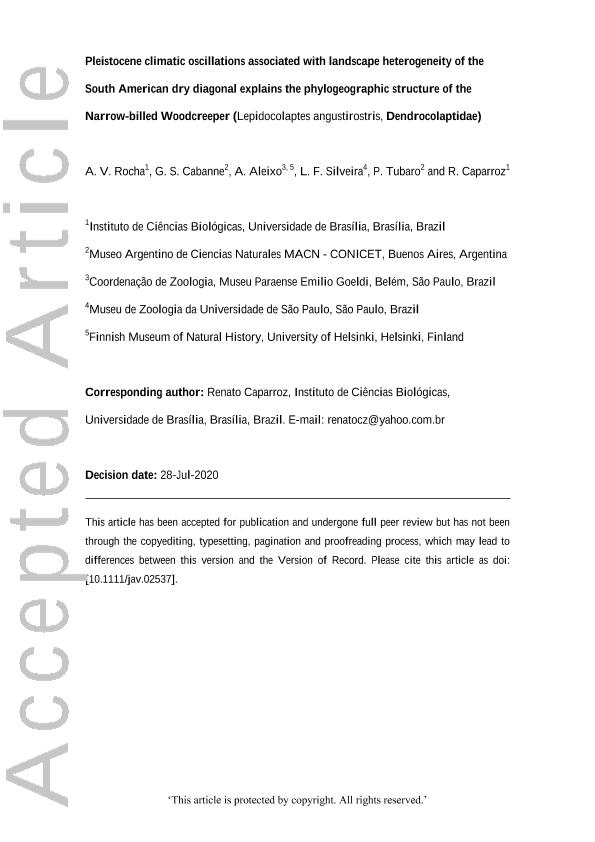Mostrar el registro sencillo del ítem
dc.contributor.author
Rocha, A. V.
dc.contributor.author
Cabanne, Gustavo Sebastián

dc.contributor.author
Aleixo, A.
dc.contributor.author
Silveira, L. F.
dc.contributor.author
Tubaro, Pablo Luis

dc.contributor.author
Caparroz, R.
dc.date.available
2021-10-05T14:24:47Z
dc.date.issued
2020-08
dc.identifier.citation
Rocha, A. V.; Cabanne, Gustavo Sebastián; Aleixo, A.; Silveira, L. F.; Tubaro, Pablo Luis; et al.; Pleistocene climatic oscillations associated with landscape heterogeneity of the South American dry diagonal explains the phylogeographic structure of the narrow-billed woodcreeper (Lepidocolaptes angustirostris, Dendrocolaptidae); Wiley Blackwell Publishing, Inc; Journal Of Avian Biology; 51; 9; 8-2020; 1-38
dc.identifier.issn
0908-8857
dc.identifier.uri
http://hdl.handle.net/11336/142668
dc.description.abstract
Based on phylogeographic and niche model analyses of the narrow-billed woodcreeper Lepidocolaptes angustirostris, we evaluated the predictions of two diversification hypotheses related to the dry diagonal of South America: (I) isolation by distance (IBD) and (II) landscape heterogeneity. We also investigated the influence of the Pleistocene climatic oscillations on the diversification and population dynamic of this species, and discussed the implications of our findings for the taxonomy of this woodcreeper. We sampled 63 individuals including all subspecies described for L. angustirostris, and compared them using a mitochondrial (ND2) and a nuclear (FIB5) fragments. We performed a Mantel test and spatial autocorrelation analysis, reconstructed the phylogenetic relationships among haplotypes, investigated changes in population size and estimated divergence time among the genetic lineages. We refuted the hypothesis that bird species associated with open environments have shallow geographic differentiation and showed that strong genetic structure observed in L. angustirostris can not be explained by IBD. Paleo-modeling showed strong association between climatic stable areas and the genetic lineages, suggesting that Pleistocene climatic oscillations have primarily driven the intraspecific diversification of this species. In addition, the association between genetic lineages and the dry diagonal biomes supports that landscape heterogeneity may be acting as a secondary barrier restricting gene flow among the lineages. The genetic lineages found in L. angustirostris do not correspond to the subspecies described, indicating that this species can be considered as a single species with strong genetic structure. In conclusion, our data corroborate other studies indicating that Pleistocene climatic oscillations may have had a strong influence in the intraspecific divergence of dry diagonal fauna and that biomes of the dry diagonal should be considered as independent units in further biogeographic studies.
dc.format
application/pdf
dc.language.iso
eng
dc.publisher
Wiley Blackwell Publishing, Inc

dc.rights
info:eu-repo/semantics/openAccess
dc.rights.uri
https://creativecommons.org/licenses/by-nc-sa/2.5/ar/
dc.subject
BIOGEOGRAPHY
dc.subject
CAATINGA
dc.subject
CERRADO
dc.subject
CHACO
dc.subject
ISOLATION BY DISTANCE
dc.subject
STDFS
dc.subject.classification
Zoología, Ornitología, Entomología, Etología

dc.subject.classification
Ciencias Biológicas

dc.subject.classification
CIENCIAS NATURALES Y EXACTAS

dc.title
Pleistocene climatic oscillations associated with landscape heterogeneity of the South American dry diagonal explains the phylogeographic structure of the narrow-billed woodcreeper (Lepidocolaptes angustirostris, Dendrocolaptidae)
dc.type
info:eu-repo/semantics/article
dc.type
info:ar-repo/semantics/artículo
dc.type
info:eu-repo/semantics/publishedVersion
dc.date.updated
2021-09-07T18:13:20Z
dc.journal.volume
51
dc.journal.number
9
dc.journal.pagination
1-38
dc.journal.pais
Reino Unido

dc.journal.ciudad
Londres
dc.description.fil
Fil: Rocha, A. V.. Universidade do Brasília; Brasil
dc.description.fil
Fil: Cabanne, Gustavo Sebastián. Consejo Nacional de Investigaciones Científicas y Técnicas. Oficina de Coordinación Administrativa Parque Centenario. Museo Argentino de Ciencias Naturales "Bernardino Rivadavia"; Argentina
dc.description.fil
Fil: Aleixo, A.. Museu Paraense Emilio Goeldi; Brasil
dc.description.fil
Fil: Silveira, L. F.. Universidade de Sao Paulo; Brasil
dc.description.fil
Fil: Tubaro, Pablo Luis. Consejo Nacional de Investigaciones Científicas y Técnicas. Oficina de Coordinación Administrativa Parque Centenario. Museo Argentino de Ciencias Naturales "Bernardino Rivadavia"; Argentina
dc.description.fil
Fil: Caparroz, R.. Universidade do Brasília; Brasil
dc.journal.title
Journal Of Avian Biology

dc.relation.alternativeid
info:eu-repo/semantics/altIdentifier/url/https://onlinelibrary.wiley.com/doi/abs/10.1111/jav.02537
dc.relation.alternativeid
info:eu-repo/semantics/altIdentifier/doi/http://dx.doi.org/10.1111/jav.02537
Archivos asociados
